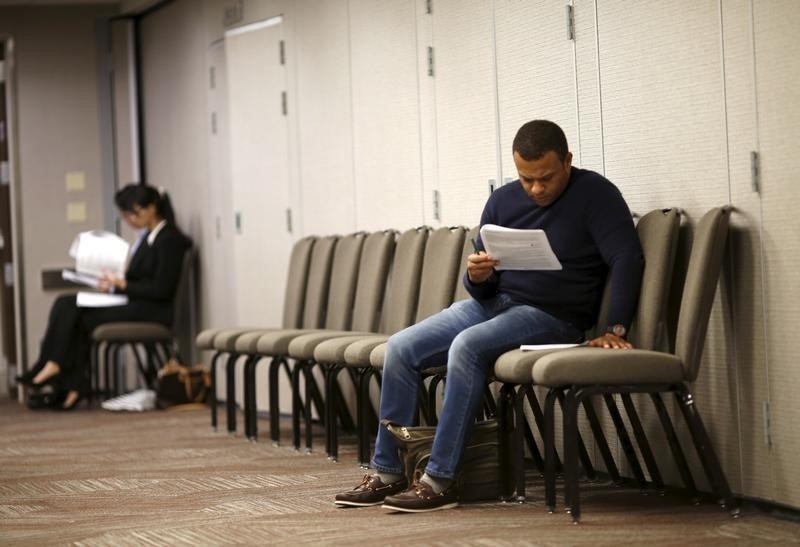By Lucia Mutikani
WASHINGTON (Reuters) - U.S. job growth surged in October and the unemployment rate hit a 7-1/2-year low of 5.0 percent in a show of economic strength that makes it much more likely the Federal Reserve will raise interest rates in December.
Nonfarm payrolls increased 271,000 last month, the largest rise since December 2014, the Labor Department said on Friday. In addition, average hourly earnings rose a respectable 9 cents. The payrolls jump followed tepid gains in August and September.
The unemployment rate now stands at its lowest level since April 2008 and is in a range many Fed officials see as consistent with full employment.
"The employment report had everything you could have asked for. It more than offsets the weakness in the prior two months and positions the Fed to hike rates in December," said Michelle Meyer, deputy U.S. chief economist at Bank of America (N:BAC) Merrill Lynch in New York.
The reaction in financial markets was swift and sharp.
The dollar rallied to a 6-1/2-month high against a basket of currencies as investors braced for higher borrowing costs. U.S. Treasury debt prices fell, with yields on the two-year note hitting a 5-1/2-year high. Stocks on Wall Street edged lower.
With speeches from several Fed officials, including Chair Janet Yellen, suggesting a low bar for a December rate increase, economists had said ahead of the report that monthly job gains above 150,000 in October and November would be sufficient grounds for the first increase in overnight borrowing costs since 2006.
The U.S. central bank, which has held rates near zero for nearly seven years, has made clear, both in its statement after its October policy meeting and Yellen's subsequent comments, that a rate hike is firmly on the table at the Dec. 15-16 meeting.
"We've indicated that conditions look like they could be right for an increase," Chicago Federal Reserve Bank President Charles Evans, who has argued against a rate hike, said in an interview with CNBC on Friday. "The real side of the economy is looking a lot better."
BROAD-BASED GAINS
Economists had forecast nonfarm payrolls increasing 180,000 last month and the unemployment rate remaining at 5.1 percent.
The report added to strong services sector and automobile sales data in painting an upbeat picture of the economy at the start of the fourth quarter. It bolstered views that growth will regain momentum this quarter after braking sharply to a 1.5 percent annual pace in the July-September period.
In addition to the unexpectedly stronger job gains last month, data for August and September were revised to show 12,000 more jobs created than previously reported.
Last month's rise in wages, which have been almost stagnant despite a tightening labor market, lifted the year-on-year reading to 2.5 percent. That was the biggest increase since July 2009 and could give the Fed confidence that inflation will gradually move towards its 2 percent target.
Combining hours, payroll gains and wages, a measure of take-home pay increased 0.6 percent in October, and was up 4.6 percent over the past 12 months.
"The economy has regained momentum just in time for the holiday shopping season," said Bob Hughes, senior research fellow at the American Institute for Economic Research in Great Barrington, Massachusetts.
There were improvements in other labor market measures that Fed officials are eyeing as they contemplate a rate hike.
A broad measure of joblessness that includes people who want to work but have given up searching and those working part-time because they cannot find full-time employment fell two-tenths of a percentage point to 9.8 percent, the lowest level since May 2008.
The employment-population ratio rose to 59.3 percent from 59.2 percent in September. But the labor force participation rate, or the share of working-age Americans who are employed or at least looking for a job, held at a near 38-year low of 62.4 percent.
Employment gains in October were broad-based, though manufacturing added no jobs and mining shed 4,000 positions as oil and gas extraction payrolls fell 2,700.
Manufacturing has been hurt by a strong dollar, efforts by businesses to reduce bloated inventory and spending cuts by energy companies cutting back on well drilling and exploration in response to lower oil prices.
The mining sector has shed 109,000 jobs since peaking in December 2014. Oilfield services provider Schlumberger last month announced further layoffs in addition to the 20,000 jobs it has already eliminated.
Construction payrolls, however, increased 31,000 last month, the biggest gain since February.
The services sector added 241,000 jobs in October, with large gains in retail, health and leisure. Professional and business services added 78,000 jobs, the largest gain since last November. Temporary help, a harbinger of future hiring, increased by 24,500 jobs, the biggest rise in nearly a year.

Government payrolls increased 3,000 last month.